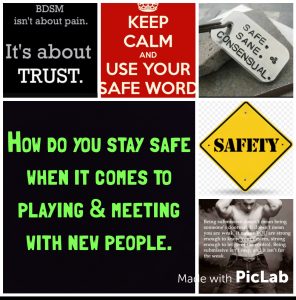What exactly is aftercare?
In simple terms, it is the time you take after a scene or playtime where both or more parties take the time to recover and take care of each other's physical and emotional needs.
Now if you are just starting out you might wonder, why exactly would you need aftercare? With BDSM or kinky play we at times tend to really get physical but besides the physical aspect, the emotional and mental side is also a big roller coaster.
Aftercare for one person would look completely different to another person’s need for aftercare. And although you might be reading a lot on aftercare in regards to submissives/bottoms, it is also for Dominants/Tops.
So to get to a few examples for you to get an idea on aftercare. Now as I said the individual’s need for aftercare will be as unique as them. So the best way to get an idea is to negotiate this ahead of time if you are playing with someone new or for the first few times. After this, it tends to be part of the continues communication flow between parties.
THERE IS NOT JUST ONE CORRECT WAY OF DOING THIS! So talk and communicate but also be ready to play it by ear afterwards.
Another thing to keep in mind that at different times the same submissive will need aftercare in a different form depending on the need of the submissive or top.
So let's divide it up into two categories to make it easier to understand:
1. Physical Needs:
Rehydrate: Have a bottle or glass of water ready nearby for afterwards. The reason is during play you will sweat and need to replace this. As a submissive might not have the coordination afterwards to drink from a glass or bottle you might want to consider having a straw to drink from.
Blankets at times to keep warm: A few submissives might want to warm embrace to cuddle into but it also has a physical need. Body temperature can drop quite quickly after play.
Something small to eat like a piece of chocolate or a cookie: (make sure on medical conditions that might prevent this). It sometimes helps to increase the blood sugar levels a little bit and also releases oxytocin. The “feel good” drug.
Now if there is any cuts, lacerations, bruises or wounds that need to be taken care off. Have a look, *disinfect and dressing* any wounds. Perhaps using a cream to reduce bruises.
If a submissive is leaving the club/venue or have to *travel* to their place of residence. Make sure they are capable of driving or call a taxi. This can be arranged ahead of time so that a third party is able to take them home. Or to wait until they are in a position to drive themselves.
There are several more examples but you get the basic idea. Physical needs are taken care off. Like helping your submissive get to a bathroom to relieve themselves and helping them to a point where they can stand on their own two feet and able to make decisions again.
2.Emotional Needs:
Lots of cuddles: Try not to leave a submissive alone by themselves as for some abandonment issues can set in. Or a feeling like they were not good enough. At times it is not possible for Tops/Dominants to be the one taking care of aftercare but if you can stay and cuddle or give encouraging words until a third person (negotiated beforehand) can take over and take care of the submissives aftercare.
Positive verbal communication: Lots of praise, gentle talking and encouragement so it is not such a big shock from going from a place of serene peace at times to a harsh wake up back in reality. Perhaps the play was a lot more degrading and humiliation and a submissive (as well as Dominants) need the time to transition back to a place of reality.
Skin to skin. For some submissives and Dominants, they need that reassurance that everything is okay and still good and they need no barriers between them.
Shower: Taking a shower or bath can be relaxing for both parties. It takes care of a physical need to getting clean but also emotional need to keep the connection and making sure both of you are okay.
There are a lot more ways some submissives needs can be taken care of emotionally so these are just a few examples to get you going and thinking about it. The needs can differ in regards to the different relationships between parties as well so please talk beforehand about what you might think you will need if you are not completely sure.
Now, most of the above might be seen that it is mostly a Dominant taking care of the submissives need but quite often afterwards a lot of Dominants have an intense need to make sure the submissive and bottom is, in fact, okay and doing good.
Other examples specific to Dominants/Tops:
After taking care of a submissive they need their alone time to be able to process things.
Taking care of equipment and cleaning everything off and packing their toys away is a ritual for some.
Needing to talk it out after their play partners are able to. What was good. What wasn't? How did you find it?
Submissives and bottoms please consider when you are able to... To give thanks the Dominant/Top for their time. You really don't know how much that means to them. You might have given them a gift of submission but they gave you a gift as well.
Dominants don't neglect you're own physical or emotional needs. For a lot of submissives aftercare involving being allowed to take care of their Dominant and that is how they best process a scene or playtime.
Aftercare at times can be used for all parties to return to their “positions” and equilibrium before a scene or play started.
When does aftercare stop or how long should it be?
This is a very difficult question to answer as the answer is as unique as the situation, circumstances and people involved. Talk, talk and more talk.
It is nice to check in now and then with someone you just started playing with. A quick text message or just knowing that you are available to talk. (no matter if you are a sub or a Dom/me)
On the scale of more 24/7, it is just a continues part of the relationship.
Please remember that there is no right or wrong way. Some individuals might not want any of the above and just want to be taken to a safe place and left alone to be able to process and detune.
Remember to stay safe and have some fun.

